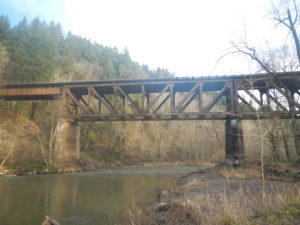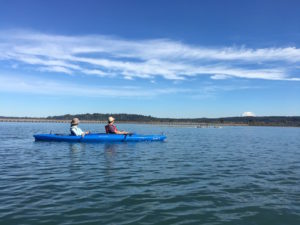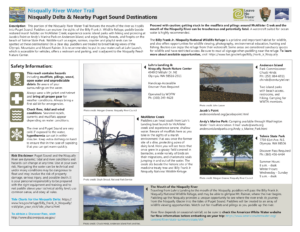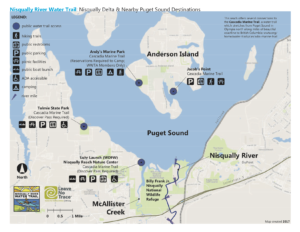The 6th Avenue to Luhr Beach section includes paddling on the Nisqually River and Puget Sound. This section features a large portion of open salt water and is best attempted by kayakers (not rafters) who are able to paddle under these conditions. It may offer multiple hazards to unexperienced boaters. It is approximately 6 miles and can take several hours to travel across the open water of Puget Sound.
Put-in at 6th Avenue Handicap Fishing Pier, which is operated by the Washington Department of Fish and Wildlife (WDFW). A Discover Pass is required for all vehicles parked on site.

The undeveloped put-in/take-out area at 6th Avenue.
- The park has a restroom and fishing pier. There is not a developed boat launch, but the parking area is located close to the bank, so it is possible to carry canoes, kayaks and/or rafts from the river to vehicles.
- A significant amount of wood and other debris can accumulate against the bank, limiting the areas that are appropriate for boats to use.
- This site is well used by fishermen and other recreationists year-round. Keep an eye out for fishing line and be prepared to share the space.
Take-out at Luhr Beach, on Puget Sound. Note that this is the only available take-out within reasonable paddling distance from this site, and features a long paddle across open water on the Nisqually Delta. Luhr Beach is operated by WDFW, and requires all vehicles display a valid Discover Pass.
- Luhr Beach has a paved boat launch and ample parking on site. The nearby Nisqually Reach Nature Center, when open, has restrooms for visitors to use.
- From October – January, waterfowl hunting is allowed in parts of the Nisqually Reach, creating the potential for conflicting uses and/or hazardous conditions.
- At low tides, this boat launch may be inaccessible to users. Check with WDFW and/or the Nisqually Reach Nature Center to learn more about appropriate tide levels when planning your trip.

A portion of this reach is on Puget Sound and requires paddling across open water.
Hazards & Safety Information
*Note: this is not an exhaustive list! River conditions can change rapidly and new hazards may appear at any time.
- Before going on any river, be sure to take steps to increase personal responsibility, boat safety, the preparedness of your group and to understand water rescue principles. American Whitewater has a comprehensive list of actions that all river users should take to increase their safety. Make sure you and everyone in your boating party follows these guidelines!
- The Nisqually River has cold and swift water, poor water visibility, log jams, boulder gardens, and other natural hazards that are subject to change. These hazards can quickly turn lethal if users are unprepared.
- This section of river has featured very large log jams in the past. It is sometimes necessary to portage around these log jams, which can prove fatal if anyone becomes trapped.
- Changing tides are an important hazard to consider while planning a trip. Low tides may make Luhr Beach inaccessible, and changing currents may make paddling more difficult that a user is prepared for. A tide chart is available here.
- There are many people who use the 6th Avenue and/or Luhr Beach boat launches, so many types of recreationists may be encountered. Motor boats are allowed at Luhr Beach, and many people launch there during waterfowl hunting season. 6th Avenue is used by fishermen during the fishing season.
- When paddling across the Nisqually Delta, users will come very close to the Billy Frank Jr. Nisqually National Wildlife Refuge (BFJNNWR). BFJNNWR has specific guidelines surrounding where boats may go, and it is important to stay outside of prohibited areas. These guidelines can be viewed on the BFJNNWR website, or information is available by calling 360-753-9467.
Map
This map and guide is available for print from this website. Download a PDF version to print here. Please note that this map is only a rough guideline of known hazards, and water conditions can change at any time. You are responsible for your own safety.

